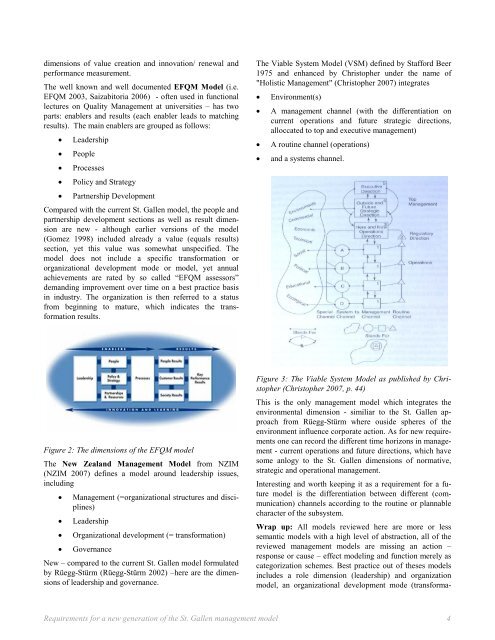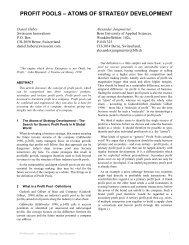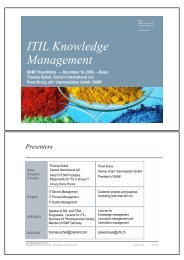requirements for a new generation of the st. gallen management ...
requirements for a new generation of the st. gallen management ...
requirements for a new generation of the st. gallen management ...
Create successful ePaper yourself
Turn your PDF publications into a flip-book with our unique Google optimized e-Paper software.
dimensions <<strong>st</strong>rong>of</<strong>st</strong>rong> value creation and innovation/ re<<strong>st</strong>rong>new</<strong>st</strong>rong>al and<br />
per<<strong>st</strong>rong>for</<strong>st</strong>rong>mance measurement.<br />
The well known and well documented EFQM Model (i.e.<br />
EFQM 2003, Saizabitoria 2006) - <<strong>st</strong>rong>of</<strong>st</strong>rong>ten used in functional<br />
lectures on Quality Management at universities – has two<br />
parts: enablers and results (each enabler leads to matching<br />
results). The main enablers are grouped as follows:<br />
• Leadership<br />
• People<br />
• Processes<br />
• Policy and Strategy<br />
• Partnership Development<br />
Compared with <<strong>st</strong>rong>the</<strong>st</strong>rong> current St. Gallen model, <<strong>st</strong>rong>the</<strong>st</strong>rong> people and<br />
partnership development sections as well as result dimension<br />
are <<strong>st</strong>rong>new</<strong>st</strong>rong> - although earlier versions <<strong>st</strong>rong>of</<strong>st</strong>rong> <<strong>st</strong>rong>the</<strong>st</strong>rong> model<br />
(Gomez 1998) included already a value (equals results)<br />
section, yet this value was somewhat unspecified. The<br />
model does not include a specific trans<<strong>st</strong>rong>for</<strong>st</strong>rong>mation or<br />
organizational development mode or model, yet annual<br />
achievements are rated by so called “EFQM assessors”<br />
demanding improvement over time on a be<strong>st</strong> practice basis<br />
in indu<strong>st</strong>ry. The organization is <<strong>st</strong>rong>the</<strong>st</strong>rong>n referred to a <strong>st</strong>atus<br />
from beginning to mature, which indicates <<strong>st</strong>rong>the</<strong>st</strong>rong> trans<<strong>st</strong>rong>for</<strong>st</strong>rong>mation<br />
results.<br />
Figure 2: The dimensions <<strong>st</strong>rong>of</<strong>st</strong>rong> <<strong>st</strong>rong>the</<strong>st</strong>rong> EFQM model<br />
The New Zealand Management Model from NZIM<br />
(NZIM 2007) defines a model around leadership issues,<br />
including<br />
• Management (=organizational <strong>st</strong>ructures and disciplines)<br />
• Leadership<br />
• Organizational development (= trans<<strong>st</strong>rong>for</<strong>st</strong>rong>mation)<br />
• Governance<br />
New – compared to <<strong>st</strong>rong>the</<strong>st</strong>rong> current St. Gallen model <<strong>st</strong>rong>for</<strong>st</strong>rong>mulated<br />
by Rüegg-Stürm (Rüegg-Stürm 2002) –here are <<strong>st</strong>rong>the</<strong>st</strong>rong> dimensions<br />
<<strong>st</strong>rong>of</<strong>st</strong>rong> leadership and governance.<br />
The Viable Sy<strong>st</strong>em Model (VSM) defined by Staf<<strong>st</strong>rong>for</<strong>st</strong>rong>d Beer<br />
1975 and enhanced by Chri<strong>st</strong>opher under <<strong>st</strong>rong>the</<strong>st</strong>rong> name <<strong>st</strong>rong>of</<strong>st</strong>rong><br />
"Holi<strong>st</strong>ic Management" (Chri<strong>st</strong>opher 2007) integrates<br />
• Environment(s)<br />
• A <strong>management</strong> channel (with <<strong>st</strong>rong>the</<strong>st</strong>rong> differentiation on<br />
current operations and future <strong>st</strong>rategic directions,<br />
alloccated to top and executive <strong>management</strong>)<br />
• A routine channel (operations)<br />
• and a sy<strong>st</strong>ems channel.<br />
Figure 3: The Viable Sy<strong>st</strong>em Model as published by Chri<strong>st</strong>opher<br />
(Chri<strong>st</strong>opher 2007, p. 44)<br />
This is <<strong>st</strong>rong>the</<strong>st</strong>rong> only <strong>management</strong> model which integrates <<strong>st</strong>rong>the</<strong>st</strong>rong><br />
environmental dimension - similiar to <<strong>st</strong>rong>the</<strong>st</strong>rong> St. Gallen approach<br />
from Rüegg-Stürm where ouside spheres <<strong>st</strong>rong>of</<strong>st</strong>rong> <<strong>st</strong>rong>the</<strong>st</strong>rong><br />
environment influence corporate action. As <<strong>st</strong>rong>for</<strong>st</strong>rong> <<strong>st</strong>rong>new</<strong>st</strong>rong> <<strong>st</strong>rong>requirements</<strong>st</strong>rong><br />
one can record <<strong>st</strong>rong>the</<strong>st</strong>rong> different time horizons in <strong>management</strong><br />
- current operations and future directions, which have<br />
some anlogy to <<strong>st</strong>rong>the</<strong>st</strong>rong> St. Gallen dimensions <<strong>st</strong>rong>of</<strong>st</strong>rong> normative,<br />
<strong>st</strong>rategic and operational <strong>management</strong>.<br />
Intere<strong>st</strong>ing and worth keeping it as a requirement <<strong>st</strong>rong>for</<strong>st</strong>rong> a future<br />
model is <<strong>st</strong>rong>the</<strong>st</strong>rong> differentiation between different (communication)<br />
channels according to <<strong>st</strong>rong>the</<strong>st</strong>rong> routine or plannable<br />
character <<strong>st</strong>rong>of</<strong>st</strong>rong> <<strong>st</strong>rong>the</<strong>st</strong>rong> subsy<strong>st</strong>em.<br />
Wrap up: All models reviewed here are more or less<br />
semantic models with a high level <<strong>st</strong>rong>of</<strong>st</strong>rong> ab<strong>st</strong>raction, all <<strong>st</strong>rong>of</<strong>st</strong>rong> <<strong>st</strong>rong>the</<strong>st</strong>rong><br />
reviewed <strong>management</strong> models are missing an action –<br />
response or cause – effect modeling and function merely as<br />
categorization schemes. Be<strong>st</strong> practice out <<strong>st</strong>rong>of</<strong>st</strong>rong> <<strong>st</strong>rong>the</<strong>st</strong>rong>ses models<br />
includes a role dimension (leadership) and organization<br />
model, an organizational development mode (trans<<strong>st</strong>rong>for</<strong>st</strong>rong>ma-<br />
Requirements <<strong>st</strong>rong>for</<strong>st</strong>rong> a <<strong>st</strong>rong>new</<strong>st</strong>rong> <<strong>st</strong>rong>generation</<strong>st</strong>rong> <<strong>st</strong>rong>of</<strong>st</strong>rong> <<strong>st</strong>rong>the</<strong>st</strong>rong> St. Gallen <strong>management</strong> model 4




